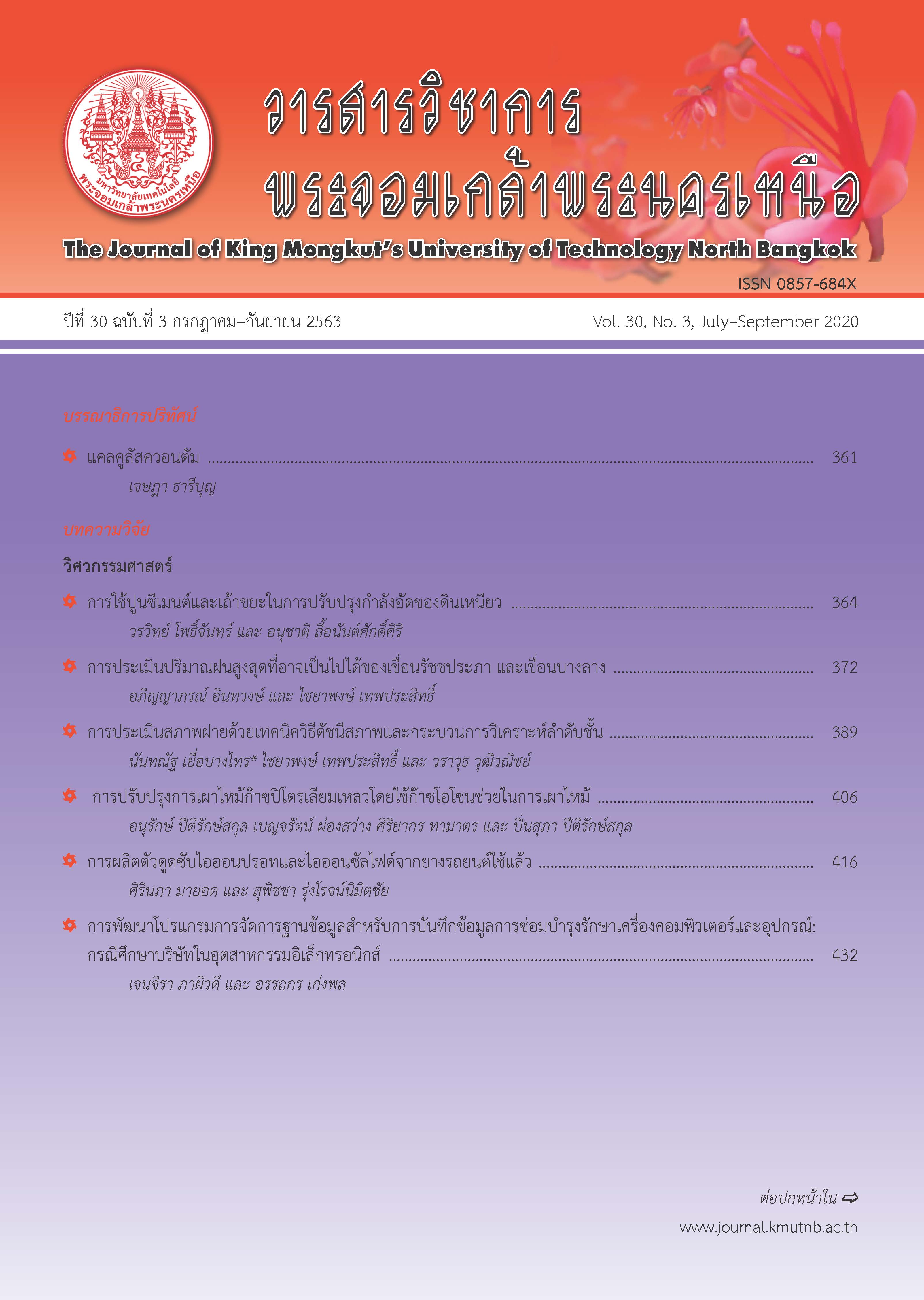Estimate of Probable Maximum Precipitation (PMP) of Rajjaprabha Dam and Bang Lang Dams
Main Article Content
Abstract
This study aims to examine the estimation of Probable Maximum Precipitation (PMP) by using transposition and statistical method in southern of Thailand scoped with the catchment area of Rajjaprabha dam in Surat Thani province and Bang Lang dam in Yala province. The PMP results from both methods are compared with those derived of earlier studies. Data used consists of 14 previous and most influential storm events in conjunction with dew point temperature, allowing the computation of the maximum probable water in the atmosphere, and one, two and three-day maximum precipitation at rain station. According to the estimation results using transposition method, it was found that the highest PMP rainstorm during 1, 2 and 3 days is Depression 076 during 31st October – 4th November 1969. The storm center was near Hua-Hin district, Prachuap Khiri Khan province. When transposing the storm to Rajjaprabha dam, 892.74, 1,254.45 and 1,510.91 millimeters of PMP were provided, respectively. In addition, storm transposition to Bang Lang dam provided 575.13, 808.15, and 973.39 millimeters of PMP, respectively. Regarding to the estimation results of PMP by using statistical method, it was found that Station 610062 in Thakanorn sub-district, Kiriratnikom district, Surat Thani province was the highest PMP station during 1, 2, and 3 days in the catchment area of Rajjaprabha dam. The PMP results were 734.90, 1,205.13, and 1,829.36 millimeters while Station 710101 in Bachao district, Bannangsta district, Yala province was the highest PMP station during 1,2, and 3 days in the catchment area of Bang Lang dam. The PMP results were 612.80, 960.06 and 1,292.97 millimeters. The comparison of both methods shows that PMP estimation using the statistical method provides higher PMP results than the PMP from transposition method, which accounted for 21.08 percent for Rajjaprabha dam and 32.83 percent for Bang Lang dam. The comparison of previous PMP between Rajjaprabha and Bang Lang Dam demonstrates that the statistical method still gives higher PMP estimates. The study results show that precipitation in southern part of Thailand is mostly caused by the impact of intertropical convergence zone rather than the rainstorm. Using a statistical method for PMP estimation exhibits a more appropriate value for the analysis of Probable Maximum Flood (PMF) than using transposition method. Undeniably, in spillway design emphasizing dam safety and security, extreme flood events need to be taken into consideration for estimating future runoff.
Article Details
The articles published are the opinion of the author only. The author is responsible for any legal consequences. That may arise from that article.
References
[2] C. Jothityangkoon, C. Hirunteeyakul, K. Boonrawd, and M. Sivapalan, “Assessing the impact of climate and land use changes on extreme floods in a large tropical catchment,” Journal of Hydrology, vol. 490, pp. 88–105, 2013.
[3] Thai Meteorological Department. (2017). Tropical cyclone in Thailand. Thai Meteorological Department. Bangkok, Thailand [Online] Available: https://www.tmd.go.th/info/info.php?FileID=24
[4] P. Aueteerasarun, K. Sukosi, C. Thepprasit, and N. Marjang, “Probable maximum precipitation and probable maximum flood,” in Proceedings THAICID NATIONAL SYMPOSIUM, Bangkok, 2018, pp. 92–102 (in Thai).
[5] N. Wangwongwiroj and C. Khemngoen, ”Probable maximum precipitation for northern and northeastern parts of Thailand,” KMUTT Research and Development Journal, vol. 40, no. 2, pp. 255–270, 2017 (in Thai).
[6] E. M. Hansen, F. K. Schwarz, and J. T. Riedel, “Probable maximum precipitation estimates, Colorado River and Great Basin drainages,” U.S. Government Printing Office, Washington, D.C., hydrometeorological Report No. 49, 1984.
[7] Hydrometeorological Branch Office of Hydrology Weather Bureau, “Probable Maximum Precipitation, Mekong River Basin,” U.S. Government Printing Office, Washington, D.C., hydrometeorological Report No. 46, 1970.
[8] W.M. Gray, ”Global view of the origin of tropical disturbances and storms,” Monthly Weather Review, vol. 96, no. 10, pp. 669–700, 1968.
[9] S. R. Chavana and V. V. Srinivasa, “Probable maximum precipitation estimation for catchments in Mahanadi river basin,” Aquatic Procedia, vol. 4, 2015, pp. 892–899.
[10] D. M. Hershfield, ”Method for estimating probable maximum rainfall,” Journal American Water Works Association, vol. 57, no. 8, pp. 965–972, 1965.
[11] V.T. Chow, D.R. Maidment, and L.W. Mays, “Frequency analysis,” in Applied Hydrology, McGraw-Hill, Inc., 1988, pp. 389–391.
[12] D. M. Hershfield, ”Estimating the probable maximum precipitation,” Journal of the Hydraulic Division, vol. 87, no. 5, pp. 99–116, 1961.
[13] L. L. Weiss, “Ratio of true to fixed interval maximum rainfall,” Journal of the Hydraulics Division, vol. 90, no. 1, pp. 77–82, 1964.
[14] Sverdrup & Parcel International, Inc., “Pattani River Project Feasibility,” Royal Irrigation Department, Thailand, 1969.

